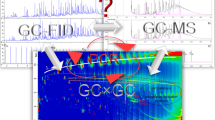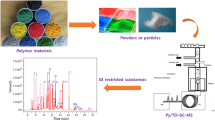Abstract
An approach using pyrolysis with comprehensive two-dimensional gas chromatography with flame ionization detection is introduced for identifying common isolated plastic polymers. A quadrupole mass spectrometer is employed as a parallel detector to aid method development and improve polymer identification in complex matrices. Common plastic polymers including polyethylene, polypropylene, polystyrene, polyvinyl chloride, polyamide, poly(methyl methacrylate), styrene-butadiene rubber, and polyethylene terephthalate are accurately identified within a total analysis time of 45 min. A strategy to enhance compatibility of high-resolution capillary gas chromatography using a 150-µm internal diameter column technology and a larger internal volume microfurnace–based pyrolyzer is discussed. This strategy resulted in minimizing the band broadening effect caused by the pyrolyzer’s internal volume and overcoming the slow pressure buildup when the sample is inserted into the furnace. Prolonged pressure buildup to reach a final pressure setting can cause a safety shutdown to the pneumatic control system. The developed approach is complementary to spectroscopic techniques by offering mass based, chemical composition analysis of plastics.








Similar content being viewed by others
References
Gironi F, Piemonte V. Bioplastics and petroleum-based plastics: strengths and weaknesses. Energy Sources, Part A: Recovery, Utilization, Environ Effects. 2011;33:1949–59. https://doi.org/10.1080/15567030903436830.
Echchakoui S, Barka N. Industry 40 and its impact in plastics industry: a literature review. J Ind Inf Integr. 2020;20:100172. https://doi.org/10.1016/j.jii.2020.100172.
Paletta A, Filho WL, Balogun A, Foschi E, Bonoli A. Barriers and challenges to plastics valorization in the context of a circular economy: case studies from Italy. J Clean Prod. 2019;241:118149. https://doi.org/10.1016/j.jclepro.2019.118149.
Lobo H, Bonilla JV. Handbook of plastic analysis. New York: Marcel Dekker; 2003.
Thompson RN, Nau CA, Lawrence CH. Identification of vehicle tire rubber in roadway dust. Am Ind Hyg Assoc J. 1966;27:488–95. https://doi.org/10.1080/00028896609342461.
Renner G, Schmidt TC, Schram J. Analytical methodologies for monitoring micro(nano) plastics: which are fit for purpose? Curr Opin Environ Sci Health. 2018;1:55–61. https://doi.org/10.1016/j.coesh.2017.11.001.
Primpke S, Lorenz C, Rascher-Friesenhausen R, Gerdts G. An automated approach for microplastics using focal plane array (FPA) FT-IR microscopy and image analysis. Anal Methods. 2017;9:1499–511. https://doi.org/10.1039/C6AY02476A.
Cowger W, Gray A, Christiansen SH. Critical review of processing and classification techniques for images and spectra in microplastic research. Appl Spectrosc. 2020;74:989–1010. https://doi.org/10.1177/0003702820929064.
Collard F, Gilbert B, Eppe G, Parmentier E, Das K. Detection of anthropogenic particles in fish stomachs: an isolation method adapted to identification by Raman spectroscopy. Arch Environ Contam Toxicol. 2015;69:331–9. https://doi.org/10.1007/s00244-015-0221-0.
Lenz R, Enders K, Stedmon CA, Mackenzie DMA, Nielsen TG. A critical assessment of visual identification of marine microplastic using Raman spectroscopy for analysis improvement. Mar Pollut Bull. 2015;100:82–91. https://doi.org/10.1016/j.marpolbul.2015.09.026.
Wolff S, Kerpen J, Prediger J, Barkmann L, Muller L. Determination of the microplastics emission in the effluent of a municipal wastewater treatment plant using Raman microspectroscopy. Water Res X. 2019;2:100014. https://doi.org/10.1016/j.wroa.2018.100014.
Tsuge S, Okumoto T, Takeuchi T. Structural investigation of chlorinated polyethylenes by pyrolysis-gas chromatography. Macromolecules. 1969;2:200–2. https://doi.org/10.1021/ma60008a019.
Tsuge S, Otani H, Watanabe C. Pyrolysis-GC/MS data book of synthetic polymers — pyrograms, thermograms, and MS of pyrolysates. Nederland: Elsevier; 2011.
Tsuge S, Takeuchi T. Vertical furnace-type sampling device for pyrolysis gas chromatography. Anal Chem. 1977;49:348–50. https://doi.org/10.1021/ac50010a044.
Cauwenberghe LV, Devriese L, Galgani F, Robbens J, Janssen CR. Microplastics in sediments: a review of techniques, occurrence, and effects. Mar Environ Res. 2015;111:5–17. https://doi.org/10.1016/j.marenvres.2015.06.007.
de Leeuw JW, de Leer EWB, Sinninghe Damste JS, Schuyl PJW. Screening of anthropogenic compound in polluted sediments and soils by flash evaporation/pyrolysis GC-MS. Anal Chem. 1986;58:1852–7. https://doi.org/10.1021/ac00121a055.
Fabbri D, Trombini C, Vassura I. Analysis of polystyrene in polluted sediments by pyrolysis gas chromatography mass spectrometry. J Chromatogr Sci. 1998;36:600–4. https://doi.org/10.1093/chromsci/36.12.600.
Fabbri D. Use of pyrolysis-gas chromatography/mass spectrometry to study environmental pollution caused by synthetic polymers: a case study: the Ravenna Lagoon. J Anal Appl Pyrolysis. 2001;58–59:361–70. https://doi.org/10.1016/S0165-2370(00)00170-4.
Guan X, Luong J, Yu Z, Jiang H. Quasi-stop-flow modulation strategy for comprehensive two-dimensional gas chromatography. Anal Chem. 2020;92:6251–6. https://doi.org/10.1021/acs.analchem.0c00814.
Biagini E, Lippi F, Tognotti L. Characterization of a lab-scale platinum filament pyrolyzer for studying the fast devolatilization of solid fuels. Fuel. 2006;85:2408–18. https://doi.org/10.1016/j.fuel.2006.06.002.
Ericsson I. Influence of pyrolysis parameters on results in pyrolysis-gas chromatography. J Anal Appl Pyrol. 1985;8:73–86. https://doi.org/10.1016/0165-2370(85)80016-4.
Wampler TP, Levy EJ. Reproducibility in pyrolysis: recent pyrolysis. J Anal Appl Pyrol. 1987;12:75–82. https://doi.org/10.1016/0165-2370(87)85058-1.
Onishi A, Oguri N, Kim P. Development of a new injection system for Curie-point pyrolysis-gas chromatography. J Chromatogr Sci. 1993;31:380–3. https://doi.org/10.1093/chromsci/31.9.380.
Buhler C, Simon W. Curie point pyrolysis gas chromatography. J Chromatogr Sci. 1970;8:323–9. https://doi.org/10.1093/chromsci/8.6.323.
Buco S, Moragues M, Doumeng P, Noor A, Mille G. Analysis of polycyclic aromatic hydrocarbons in contaminated soil by Curie point pyrolysis coupled to gas chromatography-mass spectrometry, an alternative to conventional method. J Chromatogr A. 2004;1026:223–9. https://doi.org/10.1016/j.chroma.2003.11.065.
White RL. Microfurnace pyrolysis injector for capillary gas chromatography. J Anal Appl Pyrol. 1991;18:269–76. https://doi.org/10.1016/0165-2370(91)87007-9.
Jeknavorian AA, Mabud MA, Barry EF, Litzau JJ. Novel pyrolysis-gas chromatography/mass spectrometric techniques for the characterization of chemical additives in Portland cement and concrete. J Anal Appl Pyrol. 1998;46:85–100. https://doi.org/10.1016/S0165-2370(98)00073-4.
Pico Y, Barcelo D. Pyrolysis gas chromatography-mass spectrometry in environmental analysis: focus on organic matter and microplastics. Trends Anal Chem. 2020;130:115964. https://doi.org/10.1016/j.trac.2020.115964.
Hosaka A, Watanabe C, Tsuge S. Development of new “flow-through” sample cup for the vertical micro-furnace pyrolyzer to reduce undesirable secondary reactions and band broadening of resulting pyrolysates. J Anal Appl Pyrol. 2007;78:452–5. https://doi.org/10.1016/j.jaap.2006.09.002.
Acknowledgements
Drs. Naoko Akiya, Jaime Curtis-Fisk, Wayde Konze, Tonya Stockman, and Peilin Yang of Dow Chemical, Analytical Science, Core R&D are acknowledged for their encouragement and support. Drs. Grace Xiuhan Yang and Cristina Serrat, also of Dow, are acknowledged for their help in reviewing and preparing the manuscript. Ms. Poly de Minnows is acknowledged for being an inspiration to research in environmental science. Ms. Catherine Gelmini is acknowledged for her help with the graphics.
Funding
This project is partially funded by the Dow Internal 2022 Analytical Science Capability Development Fund.
Author information
Authors and Affiliations
Contributions
The manuscript was written with the contributions of all authors. All authors have approved the final version of the manuscript.
Corresponding author
Ethics declarations
Conflict of interest
The authors declare no competing interests.
Additional information
Publisher’s note
Springer Nature remains neutral with regard to jurisdictional claims in published maps and institutional affiliations.
Published in the topical collection Comprehensive 2D Chromatography with guest editors Peter Q. Tranchida and Luigi Mondello.
Supplementary information
Below is the link to the electronic supplementary material.
Rights and permissions
Springer Nature or its licensor (e.g. a society or other partner) holds exclusive rights to this article under a publishing agreement with the author(s) or other rightsholder(s); author self-archiving of the accepted manuscript version of this article is solely governed by the terms of such publishing agreement and applicable law.
About this article
Cite this article
Luong, J., Gras, R., Hua, Y. et al. Fingerprinting and identification of isolated plastic polymers with pyrolysis comprehensive two-dimensional gas chromatography and flame ionization detection. Anal Bioanal Chem 415, 2483–2492 (2023). https://doi.org/10.1007/s00216-022-04424-6
Received:
Revised:
Accepted:
Published:
Issue Date:
DOI: https://doi.org/10.1007/s00216-022-04424-6




